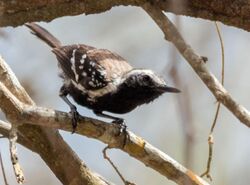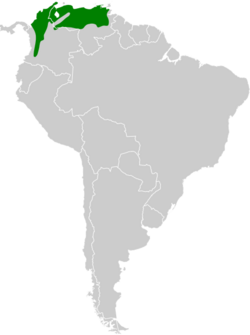Biology:Northern white-fringed antwren
| Northern white-fringed antwren | |
|---|---|

| |
| Scientific classification | |
| Domain: | Eukaryota |
| Kingdom: | Animalia |
| Phylum: | Chordata |
| Class: | Aves |
| Order: | Passeriformes |
| Family: | Thamnophilidae |
| Genus: | Formicivora |
| Species: | F. intermedia
|
| Binomial name | |
| Formicivora intermedia Cabanis, 1847
| |

| |
The northern white-fringed antwren (Formicivora intermedia) is an insectivorous bird in the antbird family Thamnophilidae. It is a resident breeder in tropical South America and occurs in northern Colombia, northern Venezuela and on the islands of Tobago and Margarita.
Taxonomy
The German ornithologist Jean Cabanis described the northern white-fringed antwren in 1847 and coined its current binomial name Formicivora intermedia.[2] It was formerly considered conspecific with the southern white-fringed antwren (Formicivora grisea) but is now often treated as a separate species based on the difference in vocalization.[3][4]
There are six subspecies:[5]
- Formicivora intermedia alticincta Bangs, 1902 – Isla del Rey (Panama)
- Formicivora intermedia hondae (Chapman, 1914) – northwest Colombia
- Formicivora intermedia fumosa (Cory, 1913) – northeast Colombia and west Venezuela
- Formicivora intermedia intermedia Cabanis, 1847 – north Colombia and north Venezuela, Margarita Island (off Venezuela)
- Formicivora intermedia tobagensis Dalmas, 1900 – Tobago Island
- Formicivora intermedia orenocensis Hellmayr, 1904 – south central Venezuela
Description
The northern white-fringed antwren is 12–13 cm (4.7–5.1 in) long, and weighs 9–12 g (0.32–0.42 oz). The male of the nominate subspecies has grayish brown upperparts, a blackish tail and blackish wings with white spots on the coverts and a white bar. A white supercilium extends as a broad stripe down the side of the breast and body. The underparts are black. The female has upperparts similar to that of the male but the underparts are buff with darker spots or streaking on the breast.[6]
References
- ↑ BirdLife International (2016). "Formicivora intermedia". IUCN Red List of Threatened Species 2016: e.T103657347A104187461. doi:10.2305/IUCN.UK.2016-3.RLTS.T103657347A104187461.en. https://www.iucnredlist.org/species/103657347/104187461. Retrieved 19 November 2021.
- ↑ Cabanis, Jean (1847). "Ornithologische notizen" (in German). Archiv für Naturgeschichte 13: 186–256 [225]. https://biodiversitylibrary.org/page/14785195.
- ↑ Hilty, Steven L. (2002). Birds of Venezuela (2nd ed.). Princeton, New Jersey: Princeton University Press. p. 534. ISBN 978-0-691-09250-8.
- ↑ Boesman, Peter (April 2016). "Notes on the vocalizations of White-fringed Antwren (Formicivora grisea)". HBW Alive Ornithological Note 46. http://www.hbw.com/node/931754. Retrieved 17 March 2018.
- ↑ Gill, Frank; Donsker, David, eds (2018). "Antbirds". World Bird List Version 8.1. International Ornithologists' Union. http://www.worldbirdnames.org/bow/antbirds/. Retrieved 16 March 2018.
- ↑ del Hoyo, J.; Collar, N.; Kirwan, G.M. (2018). "Northern White-fringed Antwren (Formicivora intermedia)". in del Hoyo, J.; Elliott, A.; Sargatal, J. et al.. Handbook of the Birds of the World Alive. Lynx Edicions. https://www.hbw.com/node/1343584. Retrieved 17 March 2018.
External links
Wikidata ☰ Q12257912 entry
 |


